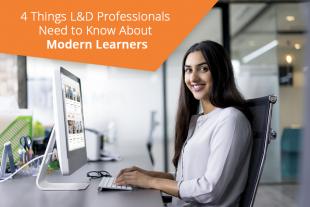Thanks to technological developments and the widespread adoption of mobile devices, learner needs are not the same as they were a few years ago. Learners have naturally evolved as new technology is introduced into both their personal and professional lives.
The question is: how have these changes impacted learner needs?
In an infographic entitled ‘Meet the Modern Learner’, Bersin by Deloitte presents a number of statistics that outline how online training is colliding with learners’ jobs, behaviors, habits, and preferences. They come to the conclusion that today’s learner is overwhelmed, distracted, and impatient.
Let’s take a closer look at each of these needs to better understand how learning programs must evolve in order to increase effectiveness.
No time to learn
It’s estimated that workers spend only 1% of the average workweek (37 minutes) on their employers’ training. Similarly, a recent survey found that knowledge workers spend 41% of their time on activities that offer little personal satisfaction.
Employees are clearly overwhelmed in their daily tasks and, as a result, are not placing the necessary emphasis on personal learning and development. They feel that there aren’t enough hours in a day to spend on learning initiatives.
Fortunately, learning technology (like a state-of-the-art learning management system) has opened up a number of capabilities that make corporate training more efficient for learners. For example, microlearning content (which involves producing bite-sized pieces of learning content) can allow learners to quickly and easily consume new information.
Thin patience
According to Statistics Brain, the average human attention span in 2015 was estimated to be 8.25 seconds – that’s shorter than the attention span of a goldfish (which is believed to be 9 seconds). Statistics Brain also reports that the average length watched of a single online video is only 2.7 minutes.
Learners simply don’t have the patience or the attention span necessary to engage with training. This is hugely problematic – lack of engagement can impact knowledge retention and learning motivation.
The more your learners have to sit through irrelevant and unengaging training sessions, the less effective your training will be. Consider introducing a personalized learning strategy to increase relevance. Similarly, centralizing your content in an LMS and will improve its accessibility and allow your learners to access materials at the point-of-need.
Constant distractions
Think about your own workflow at work – odds are, you feel like you’re spending a good chunk of your day checking your email (not to mention those Slack notifications that are driving you off the wall). Well, you’re not crazy – there are numbers to back you up.
Statistics Brain also reports that the average office worker checks their email inbox 30 times in an hour. Similarly, it’s estimated that the average employee is interrupted 56 times per day, which can cost up to two hours of daily productive time. If you do the math, that can add up to over 500 hours over the course of a year – yikes.
Next-gen learning technology should be able to support learning practices such as gamification and personalization which can help to cut through the noise and increase learner motivation and engagement.
Millennial influx
In 2015, millennials officially surpassed Gen Xers as the largest generation in the US labor force. However, 63% of millennials feel that their current employer is not fully developing their leadership skills.
Investing in the development in younger workers is key for increasing employee retention and the ability to hire leadership from within. It’s also key for filling organizational knowledge gaps that form as baby boomers retire.
Meeting millennial learner needs is, once again, a question of content accessibility. Learning content must be mobile accessible, and access to the expertise of peer mentors should also be encouraged. As such, it’s important that your learning content facilitates social learning.
Meet tomorrow’s leader
The items listed above are just a few ways in which learner needs have evolved over the past few years. As long as technology continues to evolve, learner needs will continue to evolve. It’s important to have people, processes, and tools in place to keep up with these needs so your learners can continue to develop and bring success to your organization.
Learn more about meeting learner needs in Docebo’s free whitepaper, Tapping Into the Power of Personalized Learning.
About the Author: Victoria Hoffman is a Content Specialist at Docebo. She is a graduate of University of Toronto’s Semiotics & Communication Theory Program and has 5+ years of experience in digital marketing. She enjoys writing and is always looking for a good book recommendation.






